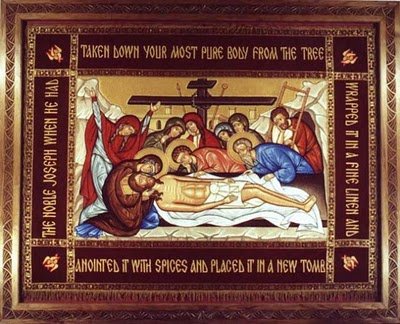The happenings of Great and Good Friday are proclaimed in our Church not only by word but also by dramatic action. It is one of the most beautiful services of our worship cycle. One of the prominent symbols of Good Friday is the Plaschanitsa (Slavonic) or Epitaphion (Greek). It is a large rectangular piece of cloth on which is painted or embroidered the Body of the dead Christ. The
occupies an integral part of the Good Friday Vespers service. It speaks eloquently of God’s absolute love. It is considered by some to be a vestige of the winding sheet in which our Lord’s body was wrapped when it was laid in the tomb.
The origin of the Plaschanitsa, which we use on Good Friday, is intriguing but vague. It is of comparatively recent date. It was unknown to the Eastern Church for about fifteen hundred years.
Two things I believe are important to note. First, when the Plaschanitsa is removed from the grave, it is placed on the Throne (Table or Altar) and the Eucharistic Liturgy is celebrated on it for 40 days, until the Feast of the Ascension. This conveys the understanding of Christ being physically present to the first Christian community for the 40 days after His resurrection.
The second important thing to note is that a smaller version of this same Plaschanitsa is always on the Throne and it must be present when the Divine Liturgy is celebrated. The relics of some saints, contained in a small wax disc, are sown into it. This replicates the fact that the early Church celebrated the Divine Liturgy in the catacombs upon the tombs of saints. This smaller version of the Plaschanitsa is called the Antimension. This is used instead of the Catholic altar stone which contains relics of saints and is cemented into the altar. During war times, all Catholic and Orthodox military chaplains use such an Antimension when they celebrate Mass or the Divine Liturgy in the field. It is quaintly called by the Roman Church the Greek Corporal.
Up to the sixteenth century, church books don’t mention our tradition of placing the Plaschanitsa in a grave and having people venerate it. One of the earliest typicons (a book that tells clergy how to celebrate services) says that during the procession with the shroud, the priest carries the shroud on his back, with a portion on his head.
The burial service, which is a part of Great and Good Friday Vespers, is, perhaps, one of the services that we are encouraged to attend during the Great and Holy Week. Being a part of the burial of Christ prepares us, in a very special way, to celebrate His Resurrection. It also reminds us that human death is but a transition to a different way of living. It is truly one of the most beautiful of all of our services during the year.

